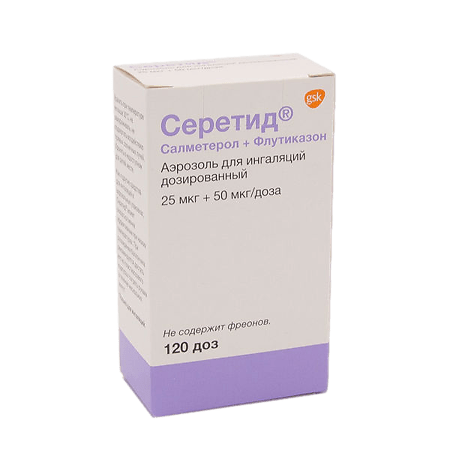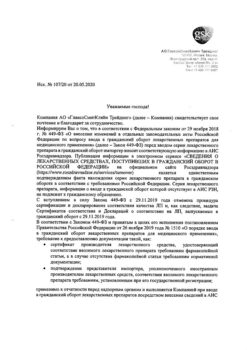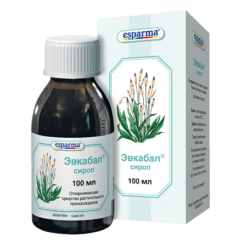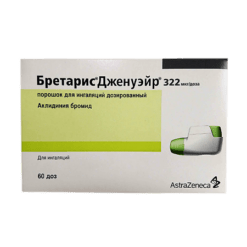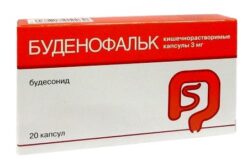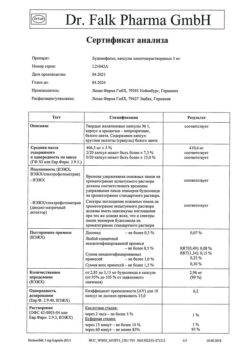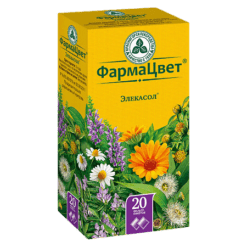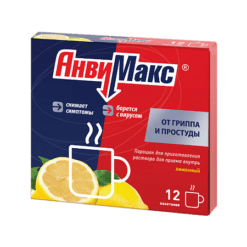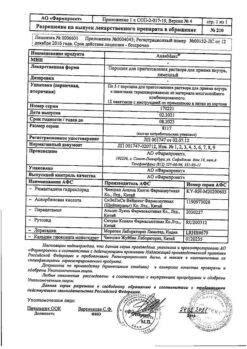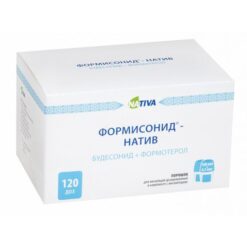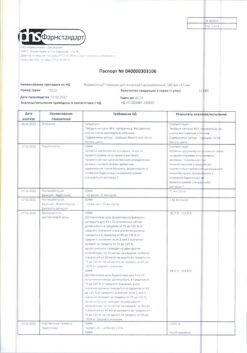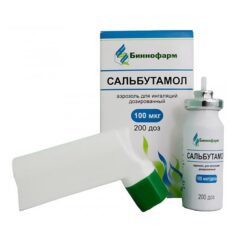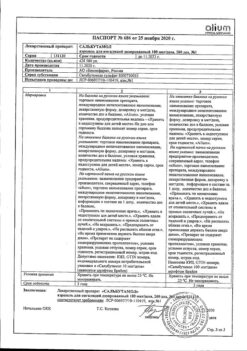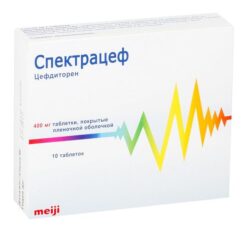No products in the cart.
Seretide, aerosol 25 mcg+50 mcg/dose 120 doses
€31.31 €26.09
Description
The drug Seretide® is a combined preparation that contains salmeterol and fluticasone propionate, which have different mechanisms of action. Salmeterol prevents symptoms of bronchospasm, fluticasone propionate improves pulmonary function and prevents exacerbation of the disease. Due to its more convenient dosing regimen, Seretide® may be an alternative for patients who simultaneously receive a β2-adrenoreceptor agonist and an inhaled GCS from different inhalers.
Salmeterol is a selective long-acting (up to 12 h) β2 adrenoreceptor agonist that has a long side chain that binds to the outer domain of the receptor.
The pharmacological properties of salmeterol provide more effective protection against histamine-induced bronchoconstriction and longer bronchodilation (lasting at least 12 hours) than short-acting β2-adrenoreceptor agonists.
In vitro studies have shown that salmeterol is a potent inhibitor of the release from the human lung of mast cell mediators such as histamine, leukotrienes and prostaglandin D2 and has a long duration of action.
Salmeterol inhibits the early and late phases of response to inhaled allergens. Inhibition of the late phase response persists for more than 30 hours after a single dose, at which time the bronchodilator effect is no longer present.
Single administration of salmeterol attenuates bronchial hyperresponsiveness. This indicates that in addition to bronchodilator activity, salmeterol has an additional action unrelated to bronchial dilation, the clinical significance of which has not been definitively established. This mechanism of action is different from the anti-inflammatory effect of GCS.
Fluticasone propionate belongs to a group of GCS for local use and when administered by inhalation in the recommended doses it has a pronounced anti-inflammatory and anti-allergic effect in the lungs, which leads to a reduction of clinical symptoms, reducing the frequency of exacerbations of bronchial asthma. Fluticasone propionate does not cause adverse effects observed with systemic corticosteroids.
In long-term use of inhaled fluticasone propionate, daily secretion of adrenal cortical hormones remains within normal limits in both adults and children, even when used at the maximum recommended doses. After switching patients receiving other inhaled GCSs to fluticasone propionate, daily adrenal hormone secretion gradually improves despite prior and current intermittent use of oral steroids. This indicates recovery of adrenal function against the background of inhaled use of fluticasone propionate. With prolonged use of fluticasone propionate, reserve function of the adrenal cortex also remains within normal limits, as evidenced by a normal increase in cortisol production in response to appropriate stimulation (it should be considered that the residual decrease in adrenal reserve caused by previous therapy may persist for a long time).
Indications
Indications
Basic therapy for diseases accompanied by reversible airway obstruction (including bronchial asthma in children and adults), when it is advisable to prescribe combination therapy – a bronchodilator and a drug from the group of inhaled corticosteroids:
– in patients receiving effective maintenance doses of long-acting beta-adrenergic receptor agonists and inhaled corticosteroids;
– in patients whose symptoms of the disease persist during therapy with inhaled corticosteroids;
– in patients receiving regular treatment with bronchodilators and requiring inhaled corticosteroids.
Maintenance therapy for COPD.
Pharmacological effect
Pharmacological effect
The drug Seretide® is a combination drug that contains salmeterol and fluticasone propionate, which have different mechanisms of action. Salmeterol prevents the occurrence of symptoms of bronchospasm, fluticasone propionate improves pulmonary function and prevents exacerbation of the disease. Due to its more convenient dosing regimen, Seretide® may be an alternative for patients who simultaneously receive a β2-adrenergic receptor agonist and inhaled corticosteroids from different inhalers.
Salmeterol is a selective, long-acting (up to 12 hours) β2-adrenergic receptor agonist with a long side chain that binds to the outer domain of the receptor.
The pharmacological properties of salmeterol provide more effective protection against histamine-induced bronchoconstriction and longer-lasting bronchodilation (lasting at least 12 hours) than short-acting β2-adrenergic receptor agonists.
In vitro studies have shown that salmeterol is a potent inhibitor of the release of mast cell mediators such as histamine, leukotrienes and prostaglandin D2 from the human lung, and has a long period of action.
Salmeterol inhibits the early and late phases of the response to inhaled allergens. Inhibition of the late phase response persists for more than 30 hours after taking a single dose, at a time when the bronchodilator effect is no longer present.
A single administration of salmeterol weakens the hyperreactivity of the bronchial tree. This indicates that salmeterol, in addition to bronchodilator activity, has an additional effect not associated with bronchial dilation, the clinical significance of which has not been fully established. This mechanism of action differs from the anti-inflammatory effect of GCS.
Fluticasone propionate belongs to the group of corticosteroids for topical use and, when administered by inhalation in recommended doses, has a pronounced anti-inflammatory and antiallergic effect in the lungs, which leads to a decrease in clinical symptoms and a decrease in the frequency of exacerbations of bronchial asthma. Fluticasone propionate does not cause the adverse effects that are observed with systemic administration of corticosteroids.
With long-term use of inhaled fluticasone propionate, the daily secretion of adrenal hormones remains within normal limits in both adults and children, even when used in the maximum recommended doses. After switching patients receiving other inhaled corticosteroids to fluticasone propionate, the daily secretion of adrenal hormones gradually improves, despite previous and current intermittent use of oral steroids. This indicates restoration of adrenal function with inhaled use of fluticasone propionate. With long-term use of fluticasone propionate, the reserve function of the adrenal cortex also remains within normal limits, as evidenced by the normal increase in cortisol production in response to appropriate stimulation (it must be taken into account that the residual decrease in adrenal reserve caused by previous therapy may persist for a long time).
Special instructions
Special instructions
Seretide is intended for long-term treatment of the disease, and not for the relief of attacks. To relieve attacks, patients should be prescribed short-acting inhaled bronchodilators (for example, salbutamol), which patients are advised to always have with them.
If paradoxical bronchospasm develops, a short-acting inhaled bronchodilator should be immediately used, Seretide should be discontinued and, if indicated, alternative therapy should be started.
Treatment of bronchial asthma is recommended to be carried out in stages, monitoring the patient’s clinical response to treatment and lung function. The patient must be taught how to use the inhaler correctly.
The severity and frequency of deepening of the voice and candidiasis can be reduced by rinsing the mouth with water after inhaling Seretide. For candidiasis, antifungal drugs are prescribed for topical use, while therapy with Seretide is continued.
More frequent use of short-acting bronchodilators to relieve symptoms indicates deterioration of disease control, in such situations the patient should consult a doctor.
Sudden and progressive deterioration in control of bronchospastic syndrome is potentially life-threatening. In such situations, medical supervision is necessary. If the dose of Seretide used does not provide adequate control of the disease, then additional administration of GCS may be required, and if an exacerbation is caused by an infection, then antibiotics are prescribed.
Due to the risk of exacerbation, sudden withdrawal of Seretide should be avoided; the dose of the drug should be reduced gradually under the supervision of a physician.
When using any inhaled GCS, it is possible to develop systemic effects (suppression of adrenal function, growth retardation in children and adolescents, decreased bone mineral density, cataracts and glaucoma), especially with long-term use in high doses, but the likelihood of such effects occurring is much lower than with treatment with oral forms of GCS. Given this, the dose of inhaled corticosteroids should be titrated to the minimum that ensures the maintenance of effective control.
In emergency and planned stressful situations, it is always necessary to remember the possibility of suppression of adrenal function and the need to use GCS.
When carrying out resuscitation or surgical interventions, it is necessary to determine the degree of adrenal insufficiency.
Some patients may experience individual high sensitivity to inhaled corticosteroids.
Due to possible adrenal insufficiency, special caution should be exercised and regular monitoring of adrenal function indicators when transferring patients who have taken oral corticosteroids to treatment with inhaled fluticasone propionate. When transferring patients from taking systemic corticosteroids to inhalation therapy, allergic reactions (for example, allergic rhinitis, eczema), which were previously suppressed by systemic corticosteroids, may occur. In such situations, it is recommended to carry out symptomatic treatment with antihistamines and/or topical drugs (including corticosteroids for topical use).
Cancellation of systemic corticosteroids against the background of inhaled fluticasone propionate should be carried out gradually. Patients should carry a card with them indicating that they may need to take additional corticosteroids in various stressful situations.
Active ingredient
Active ingredient
Salmeterol, Fluticasone
Composition
Composition
1 dose of inhalation aerosol contains:
active ingredients:
salmeterol xinafoate (equivalent to salmeterol 25 mcg) 36.3 mcg,
fluticasone propionate 50 mcg.,
excipients:
1,1,1,2-tetrafluoroethane – up to 75 mg.
Pregnancy
Pregnancy
During pregnancy and lactation (breastfeeding), Seretide can be prescribed only if the expected benefit to the mother outweighs any possible risk to the fetus or child.
Contraindications
Contraindications
– children under 4 years of age;
– hypersensitivity to the components of the drug.
The drug should be prescribed with caution for pulmonary tuberculosis, fungal, viral or bacterial infections of the respiratory system, thyrotoxicosis, pheochromocytoma, diabetes mellitus, uncontrolled hypokalemia, idiopathic hypertrophic subaortic stenosis, uncontrolled arterial hypertension, arrhythmias, prolongation of the QT interval on the ECG, ischemic heart disease, hypoxia of various origins, cataracts, glaucoma, hypothyroidism, osteoporosis, pregnancy, lactation.
Side Effects
Side Effects
Since Seretide contains salmeterol and fluticasone propionate, its side effects are characteristic of each of these drugs. Their simultaneous use does not cause additional side effects.
Seretide may cause paradoxical bronchospasm.
Salmeterol
From the cardiovascular system: palpitations, headache (usually transient, decrease as therapy with salmeterol continues); usually in predisposed patients – cardiac arrhythmias (including atrial fibrillation, supraventricular tachycardia, extrasystole).
From the digestive system: rarely – abdominal pain, nausea, vomiting; in some cases – a violation of the sense of taste.
Allergic reactions: rash, angioedema.
Other: tremor, hypokalemia (usually transient, decreases as salmeterol therapy continues); rarely – arthralgia, nervousness, peripheral edema; in some cases – irritation of the mucous membrane of the oropharynx, painful muscle spasms.
Fluticasone propionate
From the respiratory system: hoarseness, candidiasis of the oral cavity and pharynx.
Allergic reactions: skin manifestations, angioedema (mainly of the face and oropharynx), bronchospasm, anaphylactic reactions.
Systemic reactions: theoretically possible suppression of adrenal function, growth retardation in children and adolescents, decreased bone mineral density, cataracts and glaucoma.
Interaction
Interaction
The use of selective and non-selective beta-blockers should be avoided, except in cases where it is really necessary and justified.
Even despite the very low concentration of salmeterol in blood plasma, its interaction with other substrates and inhibitors of the CYP3A4 isoenzyme cannot be excluded.
When fluticasone propionate is used in the form of inhalations, its concentration in the blood plasma is low due to intensive metabolism during the “first pass” through the liver under the influence of the CYP3A4 isoenzyme and high systemic clearance. This makes a clinically significant interaction involving fluticasone propionate unlikely.
Caution must be exercised when using known CYP3A4 inhibitors and fluticasone propionate simultaneously, since in such situations the plasma levels of the latter may increase.
Ritonavir (a highly active inhibitor of the CYP3A4 isoenzyme) can cause a significant increase in the concentration of fluticasone propionate in the blood plasma, as a result of which serum cortisol concentrations are significantly reduced. There are reports of clinically significant drug interactions in patients who simultaneously received fluticasone propionate and ritonavir, which was manifested by the development of Cushing’s syndrome and suppression of adrenal function.
Given this, the simultaneous use of fluticasone propionate and ritonavir should be avoided, unless the potential benefit of combination therapy for the patient outweighs the risk of developing systemic side effects of GCS.
Other inhibitors of the CYP3A4 isoenzyme cause a negligible (erythromycin) and insignificant (ketoconazole) increase in plasma fluticasone propionate levels, with virtually no decrease in serum cortisol concentrations. Despite this, caution is recommended when using fluticasone propionate concomitantly with strong CYP3A4 inhibitors (eg, ketoconazole), since such combinations may increase the plasma concentrations of fluticasone propionate.
When used simultaneously with Seretide, xanthine derivatives, corticosteroids and diuretics increase the risk of developing hypokalemia (especially in patients with exacerbation of bronchial asthma, during hypoxia); MAO inhibitors and tricyclic antidepressants increase the risk of side effects from the cardiovascular system.
Seretide is compatible with cromoglycic acid.
Overdose
Overdose
Symptoms: tremor, headache and tachycardia caused by the action of salmeterol; temporary inhibition of the hypothalamic-pituitary-adrenal system, which is caused by the action of fluticasone.
With prolonged inhalation of Seretide in excessively high doses, noticeable suppression of adrenal function is possible. There are rare reports of acute adrenal crisis, which occurs primarily in children receiving Seretide in excessively high doses for a long time (several months or years). Acute adrenal crisis is characterized by hypoglycemia, accompanied by confusion and/or convulsions. Situations that may trigger an acute adrenal crisis include trauma, surgery, infection, or a rapid reduction in the dose of fluticasone propionate contained in Seretide.
Treatment: symptoms caused by the action of salmeterol should be relieved by administering an antidote – a cardioselective beta-blocker. In cases where discontinuation of Seretide is required due to an overdose of salmeterol, the patient should be prescribed an appropriate replacement GCS.
Symptoms caused by the action of fluticasone propionate usually do not require emergency treatment, since in most cases normal adrenal function is restored within a few days. In case of chronic overdose, it is recommended to monitor the reserve function of the adrenal cortex.
To avoid overdose, patients should not take Seretide in doses higher than recommended. It is important to regularly assess the effectiveness of therapy and reduce the dose of Seretide to the minimum level that provides effective control of the symptoms of the disease.
Storage conditions
Storage conditions
At temperatures below 30 °C
Shelf life
Shelf life
2 years
Manufacturer
Manufacturer
Glaxo Wellcome Production, France
Additional information
| Shelf life | 2 years |
|---|---|
| Conditions of storage | At temperatures below 30 °C |
| Manufacturer | Glaxo Wellcome Production, France |
| Medication form | metered aerosol for inhalation |
| Brand | Glaxo Wellcome Production |
Other forms…
Related products
Buy Seretide, aerosol 25 mcg+50 mcg/dose 120 doses with delivery to USA, UK, Europe and over 120 other countries.

